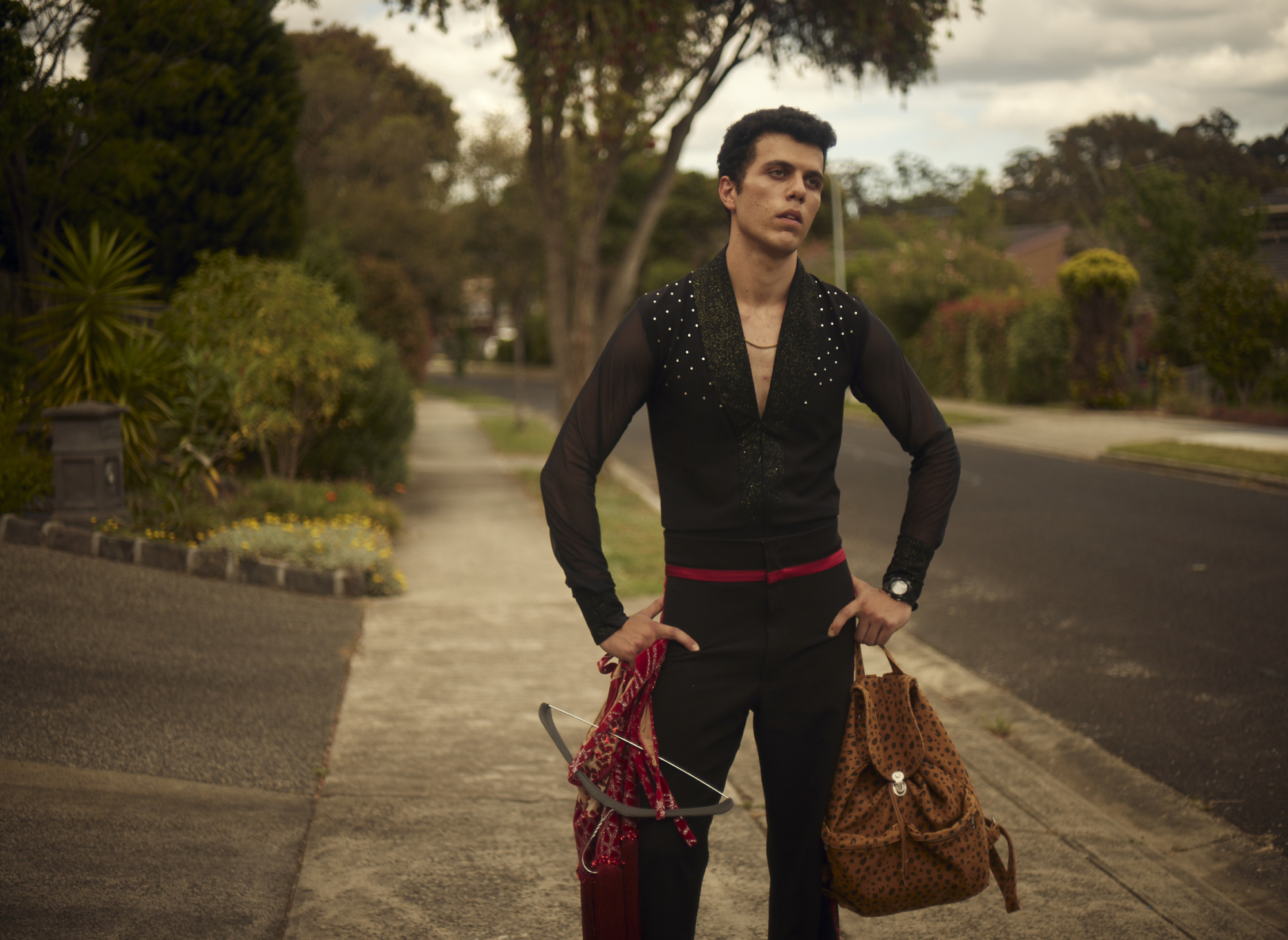Of an Age (Goran Stolevski, 2022) begins where it ends: with a young man in a crisp black tux clutching a mobile phone to his ear, barely holding back tears as he speaks, having returned to his home town. It is in this place – the suburb of Watsonia, in Melbourne’s outer north-east – that our protagonist, Kol (Elias Anton), learned about the richness and fickleness of existence. It is here that he came to understand what it means to love, to be loved back, to have love fade into a half-dream unravelling in his very presence. It is here that he became a man, the decade separating one life-defining moment and the present day only accentuating the rift between dreams once held and the desire, now faded, that fuelled them.
This seismic juncture is reached one fateful summer day in 1999 when Kol receives a frantic phone call from his best and only friend, Ebony (Hattie Hook), who has awoken on a beach. They have a dance competition in a few hours, but she has found herself on the other side of the city; flummoxed, the choleric Ebony tasks her pal with retrieving her, which sends the sensitive Kol into a spiral. He soon lands on a solution: hitching a ride with her older brother, Adam (Thom Green). En route from Watsonia to Altona, in close quarters amid humid air, the young men progress from tentative to transfixed, discovering glints of chemistry on the drive. They will cross paths a couple more times over the next twenty-four hours, but their nascent romance is ultimately doomed by Adam’s impending move to South America.
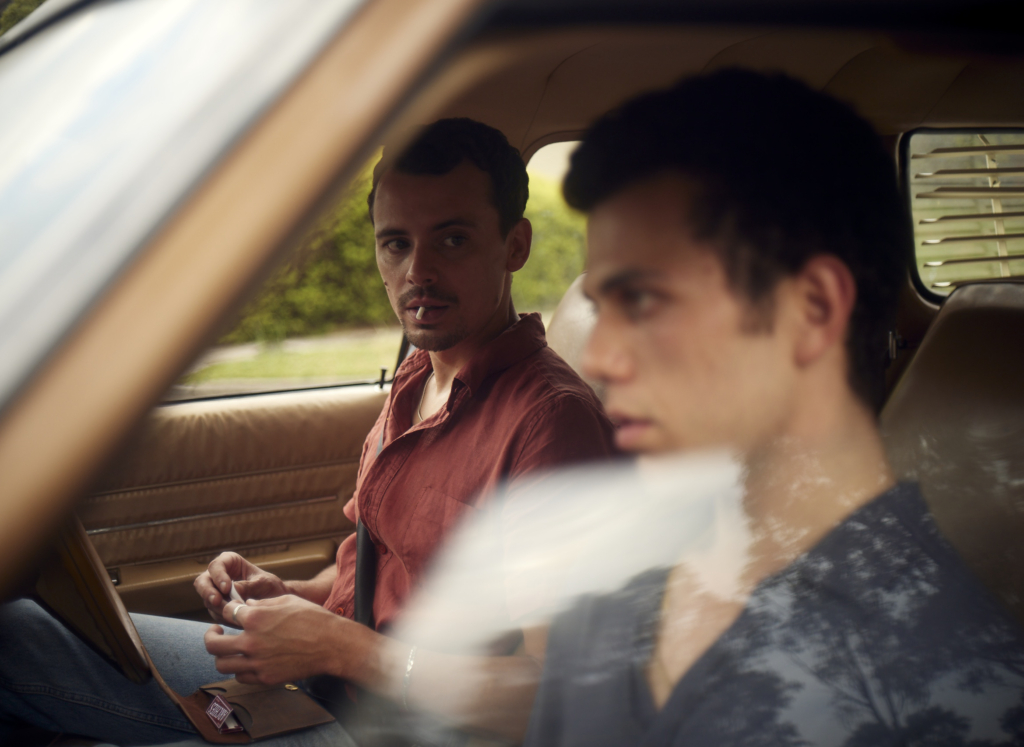
The second feature film by Macedonian-Australian writer/director Stolevski has been touted as ‘a modern queer classic’,[1]Michael Sun, ‘Of an Age Review – This Australian Film Is a Modern Queer Classic’, The Guardian, 8 August 2022, <https://www.theguardian.com/film/2022/aug/08/of-an-age-review-this-australian-film-is-a-modern-queer-classic>, accessed 13 October 2022. ‘a timeless capsule of love at its most unguarded’[2]Stephen A Russell, ‘Of an Age Is an Instant Australian Classic You Won’t Want to Miss’, Flicks.com.au, 5 August 2022, <https://www.flicks.com.au/reviews/of-an-age-is-an-instant-australian-classic-you-wont-want-to-miss/>, accessed 13 October 2022. and ‘part queer awakening, part love letter to Melbourne’s […] suburbia’.[3]Silvi Vann-Wall, ‘Of an Age Film Is a Tender and Romantic
Melburnian Treat’, ScreenHub, 8 August 2022, <https://www.screenhub.com.au/news/reviews/of-an-age-goran-stolevski-miff-2022-film-review-2557560/>, accessed 13 October 2022. That it dramatises the twin turning points of coming of age and coming out also marks it as an archetypal example of the modern male-focused queer film, alongside such contemporaries as Moonlight (Barry Jenkins, 2016), Call Me by Your Name (Luca Guadagnino, 2017), Beach Rats (Eliza Hittman, 2017), and Australian titles Tan Lines (Ed Aldridge, 2005), Newcastle (Dan Castle, 2008), Monster Pies (Lee Galea, 2013) and Teenage Kicks (Craig Boreham, 2016). More profoundly, with its inclusion of a ‘deadline’ as a narrative device and its retro-suburban milieu, Of an Age emerges as a commentary on the influence of time (and, specifically, finite temporality) on queer identities and relationships. And in weaving the two aforementioned milestones with a third – that of coming home – the film captures the pivotal role of (dis)place(ment) in young LGBTQIA+ people’s paths towards growth.
Coming into one’s own
In late August 2022, Of an Age was awarded the lucrative CinefestOZ Film Prize; competition jury president Richard Roxburgh praised the way that it ‘balanced its specificity and crafted a world that made its story a universal one’.[4]Richard Roxburgh, quoted in Sandy George, ‘Goran Stolevski’s Of an Age Wins Lucrative CinefestOZ Film Prize’, Screen Daily, 30 August 2022, <https://www.screendaily.com/news/goran-stolevskis-of-an-age-wins-lucrative-cinefestoz-film-prize/5173924.article>, accessed 9 October 2022. This mention of universality points to the by-now standard nature of the ‘queer coming-of-age’ film, which in recent years has overtaken depictions of older non-heterosexuals’ experiences[5]See Liam Taft, ‘The Problem with Gay Coming-of-age Movies’, i-D, 7 September 2018, <https://i-d.vice.com/en/article/3ke888/the-problem-with-gay-coming-of-age-movies>, accessed 13 October 2022. along with the earlier, radically grungy portrayals belonging to what theorist B Ruby Rich has called the ‘New Queer Cinema’:
[Post–New Queer Cinema] films dumped the politics overboard. Love stories, coming-out stories, and star-crossed romance tales sweetly proliferated, all executed in a normative dramatic style and deeply soothing to audiences long deprived of any such thing.[6]B Ruby Rich, New Queer Cinema: The Director’s Cut, Duke University Press, Durham, NC & London, 2013, p. 132.
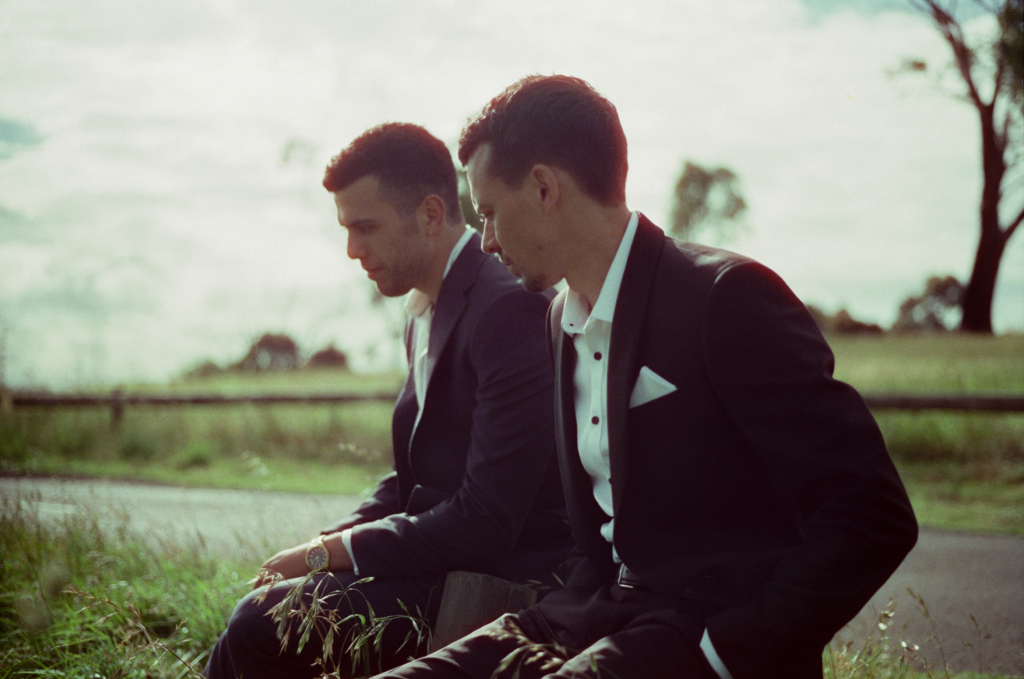
This formulaic quality is such that definitions are easy to come by. Examining the subgenre’s place in Australian queer cinema, for instance, film scholar Kelly McWilliam offers that coming-of-age works ‘focus on either one or a small group of young, usually teenaged protagonists, and the rites of passage they face in their symbolic transition to adulthood’ – namely, ‘the protagonist’s first significant experiences of love and/or sex; rebellion […] and its consequences; and, more broadly, the search for and acceptance of “their own identity”’.[7]Kelly McWilliam, ‘“It Was the Summer When Everything Changed …”: Coming of Age Queer in Australian Cinema’, in Mark David Ryan & Ben Goldsmith (eds), Australian Screen in the 2000s, Palgrave Macmillan, Cham, Switzerland, 2017, p. 193. This trope is encapsulated in the quote that functions as the title of McWilliam’s essay: ‘It was the summer when everything changed.’[8]ibid. As with Roxburgh’s ‘universal’, the word ‘everything’ carries much semantic weight: coming-of-age narratives hinge on an experiential pivot after which the protagonist’s life is irreversibly propelled forward. In this regard, it intersects neatly with the coming-out film, which presents the eponymous act – variously manifesting, according to queer academic Michael Bronski, as ‘a self-acknowledgment of same-sex desires, claiming the self-identity of being gay or lesbian, acting sexually on these desires or identity, or publicly proclaiming this identity’[9]Michael Bronski, ‘Positive Images & the Coming Out Film: The Art and Politics of Gay and Lesbian Cinema’, Cineaste, vol. 26, no. 1, 2000, pp. 20–1, 23. – as a tidy end point to a series of personal struggles.
As day turns to night and the young men deepen their bond – the film teasing us with their constant proximity – we hanker for the answer to the will-they-won’t-they posed when Kol and Adam first locked eyes in the car.
The events in Of an Age transpire over two distinct time periods. While this detail might suggest a bifurcated structure, the sections set in 2010 in fact act as bookends, with the bulk of the narrative unfolding in 1999. This privileging of the past clarifies the film’s developmental orientation: we are made privy to the moments that culminate in Kol’s entry into adulthood, and the press kit even describes him as someone ‘who doesn’t yet understand his place in the world’ and whom Adam ‘nudg[es] toward a sense of self-acceptance’.[10]Focus Features, Of an Age press kit, 2022, pp. 4, 2. Escalating the narrative stakes are the barriers imposed by Adam’s impending departure, a ‘countdown’ that precipitates the compaction of coming of age and coming out and that intensifies the line between ‘before’ and ‘after’. As day turns to night and the young men deepen their bond – the film teasing us with their constant proximity – we hanker for the answer to the will-they-won’t-they posed when Kol and Adam first locked eyes in the car. We are attuned to the conventions of the subgenre, which frames acting on queer desire as restorative, liberatory and necessary to realising, in the pithy words of researcher Gilad Padva, ‘one’s true erotic identity’.[11]Gilad Padva, ‘Edge of Seventeen: Melodramatic Coming-out in New Queer Adolescence Films’, Communication and Critical/Cultural Studies, vol. 1, no. 4, 2004, pp. 360–1, 368, emphasis added.
Certainly, Of an Age delivers on its promise of romantic fulfilment: the men consummate their love in the penultimate sequence of the ‘1999’ section, and the second ‘2010’ section confirms that Kol has continued to live as a same-sex-attracted person. But whereas other queer coming-of-age films tend to end with a protagonist having acquired an assured understanding or expression of their non-heterosexual self,[12]See Bronski, op. cit., p. 23. Stolevski’s film leaves us with the impediment of ‘pent-up, lacerating heartbreak’.[13]Focus Features, op. cit., p. 2.
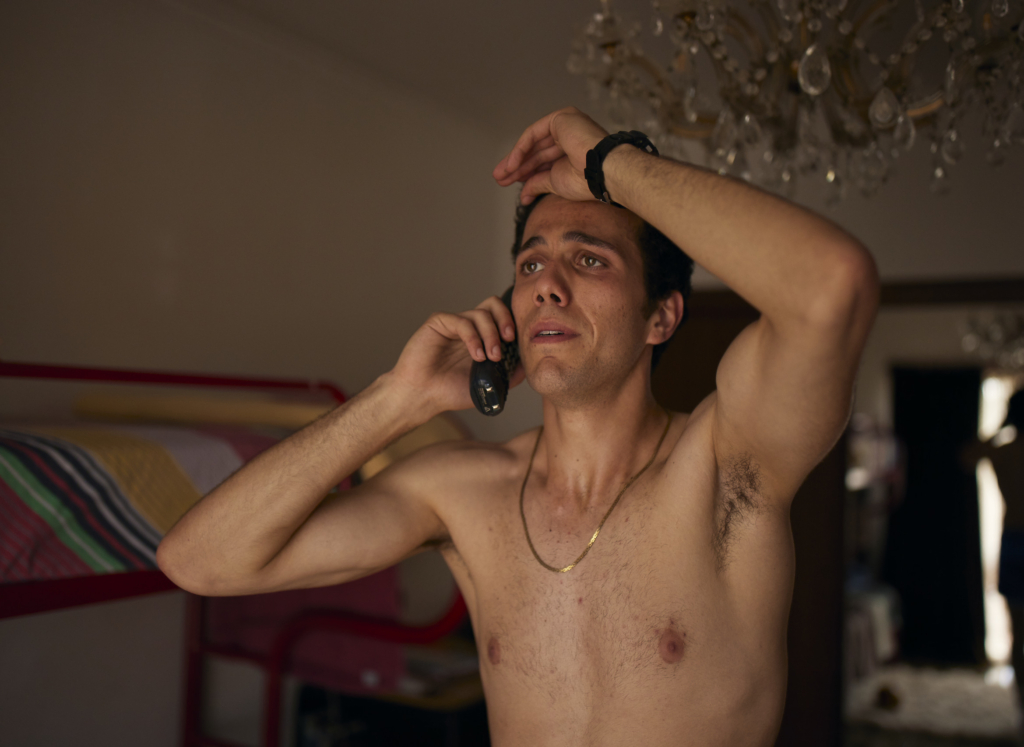
The road to belonging
Early on in the car scenes, Adam and Kol express their mutual distaste for the suburbs as a site of mediocrity; as they converse and flirt, we also learn of their shared awareness of the suburbs’ hostility towards difference – in their case, due to not just their to-be-disclosed sexuality but also their interest in culture, creativity and alternative forms of masculinity. The characters’ sentiments echo those of Stolevski, for whom, in adolescence, the suburbs were ‘prosaic, mundane and insulated’: ‘I was in this limbo state waiting for life to begin afterwards, once I was out of this space.’[14]Goran Stolevski, quoted in Focus Features, ibid., pp. 3, 4.
By now, suburbia’s reputation as an ‘aesthetic vacuum’ and a hub for heterosexual, capitalistic and conservative normativity is well established.[15]See Nicholas Manganas, ‘Queering and Querying the Australian Suburbs: Reimagining (Sub)urban Identities’, Coolabah, nos 24 & 25, 2018, pp. 353–5. For individuals who deviate from the norm by virtue of their sexuality and/or cultural background, like the Serbian-born Kol, it is a site of constant alienation, where they are multiply Othered even as they aspire to attain the so-called Australian Dream (which is inherently grounded in suburban prosperity). What’s more, suburbia’s expectations of gender, culture and sexuality are enforced through a form of diffuse policing: at the same time that the suburbs valorise individualism and privacy, so too do they facilitate an atmosphere of assumed uniformity.[16]See Julie A Podmore & Alison L Bain, ‘Whither Queer Suburbanisms?: Beyond Heterosuburbia and Queer Metronormativities’, Progress in Human Geography, vol. 45, no. 5, 2021, p. 1257. Of an Age visualises this penchant for insularity: most of the sequences involving characters other than Kol and Adam (bar, for example, one scene set in a food court, which is itself a location associated with culinary ordinariness) are set inside homes – shorthand for a preference to stay, or be stuck, within societal boxes. In such a repressive environment, it’s no wonder that the ultimate goal for those who feel ‘out of place’ is to escape.

Adam and Kol have no qualms about expressing their desire to ‘get out’ and avoid being ‘trapped’ in Watsonia. Adam has already had a taste of this, having attended the prestigious (and inner-city) University of Melbourne, and is now on the fast track to the megalopolis of Buenos Aires. For Kol, the exit is not yet in sight; however, his proverbial journey of personal discovery has been triggered by a physical journey from a place of suffocating familiarity (Watsonia) to a hitherto-unknown locale (Altona). While the film doesn’t make this explicit, it can be assumed – given his close-knit family and reserved disposition – that Kol has never left (or perhaps only rarely leaves) the confines of his suburb. The car trip thus sees him puncturing the bubble of safe sameness that has defined his life to date, guided by someone who has seen the ‘other side’. Adam doesn’t hesitate to goad his companion – a kindred creative spirit – about the wonders of the world beyond, either. Almost epitomising gender theorist Eve Kosofsky Sedgwick’s ideas around queer symbolic attachment,[17]Eve Kosofsky Sedgwick, cited in Manganas, op. cit., p. 373. he regales Kol with accounts of his love for the Spanish language, world cinema, Franz Kafka and Jorge Luis Borges – elements of culture that, like them, also subvert suburban ‘mediocrity’, thereby reassuring the teen that his affinities do ‘fit in’ somewhere. Later, Kol wears a shirt gifted him by Adam: a gestural adoption of the ‘skin’ of someone who already feels comfortable in it.
Adam’s car itself offers layers of shrewd commentary. Most obviously, it embodies mobility or fluidity – a challenge to the stagnant homogeneity of suburban homes and norms, and a means of escape (particularly when, after attending a house party populated by heterosexual youngsters, Adam and Kol use it to make a swift getaway). But the car is also a metaphor for their blossoming love’s need for enclosure, safeguarded from Othering or ostracising eyes. It’s this need for sanctuary that propels the pair to the suburbs’ fringes, where they escalate their budding attraction: they not only kiss passionately but also have sex within the vehicle. This, per subgenre convention, is intended to be read as the point of no return; we learn in the second ‘2010’ section that Kol has been living abroad, marking him as ‘out’ in more ways than one. Queer theorist Jack Halberstam terms this rite of passage ‘metronormative’:
While the story of coming out tends to function as a temporal trajectory within which a period of disclosure follows a long period of repression, the metronormative story […] is a spatial narrative within which the subject moves to a place of tolerance after enduring life in a place of suspicion, persecution, and secrecy.[18]Published under the author’s alternative name, Judith Halberstam. Halberstam, In a Queer Time & Place: Transgender Bodies, Subcultural Lives, New York University Press, New York & London, 2005, pp. 36–7.
Feminist theorist Sara Ahmed makes a similar claim: ‘Sexual orientation might also be a matter of residence, of how we inhabit spaces, and who or what we inhabit spaces with.’[19]Sara Ahmed, ‘Orientations: Toward a Queer Phenomenology’, GLQ: A Journal of Lesbian and Gay Studies, vol. 12, no. 4, 2006, p. 543. But inherent in such a choice – to remain or to run off, to flounder or to flee – is an inevitable absence of clarity. While orientations may ‘point us toward the future’, Ahmed suggests, ‘we do not know where some paths may take us’.[20]ibid., p. 554.

Bound by time
Reflecting on his script, Stolevski muses: ‘Scope doesn’t equal story-hopping across grand worlds and vistas. It means digging into a single compact human and excavating feelings the size of a universe.’[21]Stolevski, op. cit., p. 3. There’s no doubt that Of an Age is restrained in both narrative focus and style: there’s a minimalism to its arc (there are roughly just ten key plot points), and its pace is characterised by temperance and expectation. In this regard, we witness how Stolevski has skilfully manipulated the affective impact of temporality and distilled the unique shape assumed by time in the realm of queer experience.
The first is an expression of what film scholars Karl Schoonover and Rosalind Galt identify as queer cinema’s inherent register, which ‘mobiliz[es] intimacies, affects, and sensations’ and which depicts ‘kinds of love, longing, and intimacy that are often imperceptible to prevailing means of representation’.[22]Karl Schoonover & Rosalind Galt, Queer Cinema in the World, Duke University Press, Durham, NC & London, 2016, pp. 211–3. Writing in 2017 on Call Me by Your Name, which similarly anchors its love story on anticipation and a ticking clock, I argued:
The end is always in sight […] Queer people know this more than most; some of our most intimate moments are bounded by temporality. A dance with a stranger until the lights come on. A night for an app-enabled hook-up. An alarm set so you’ll have left before family breakfast. A bond created and cut short during a trip away. This temporality – the idea that [the romantic connection is] probably temporary because, we’re told, our love isn’t normal, is just a phase – compels us to not merely dive in but drown in it.[23]Adolfo Aranjuez, ‘Love in Time: Confronting Queerness in Call Me by Your Name’, Meanjin, 22 August 2017, <https://meanjin.com.au/blog/love-in-time-confronting-queerness-in-call-me-by-your-name/>, accessed 14 October 2022, emphases in original.
Like other films of this ilk – other recent comparisons include Weekend (Andrew Haigh, 2011), And Then We Danced (Levan Akin, 2019) and Monsoon (Hong Khaou, 2019) – Of an Age portrays the sensuality and stress of first love, of wanting to ‘drown in’ the attentions of the desired as time threatens from every corner. Yet it also withholds from us the pay-off that we have come to expect following decades of Hollywood indoctrination – Schoonover and Galt emphasise that queer films revel in ‘postponement, non-synchrony, and dislocation’ as well as ‘delay, deferral, and incompleteness’.[24]Schoonover & Galt, op. cit., pp. 271–2. From Kol’s stolen glances at Adam’s arms and chest, to the pair’s lingering looks, to their hug at the hill overlooking Watsonia that comprises eternity in its few seconds, Of an Age confronts us with the fleeting and circumstantial nature of the couple’s very palpable connection. After all, what Stolevski has sought to capture are ‘feelings that feel lived rather than performed’.[25]Stolevski, op. cit., p. 11.
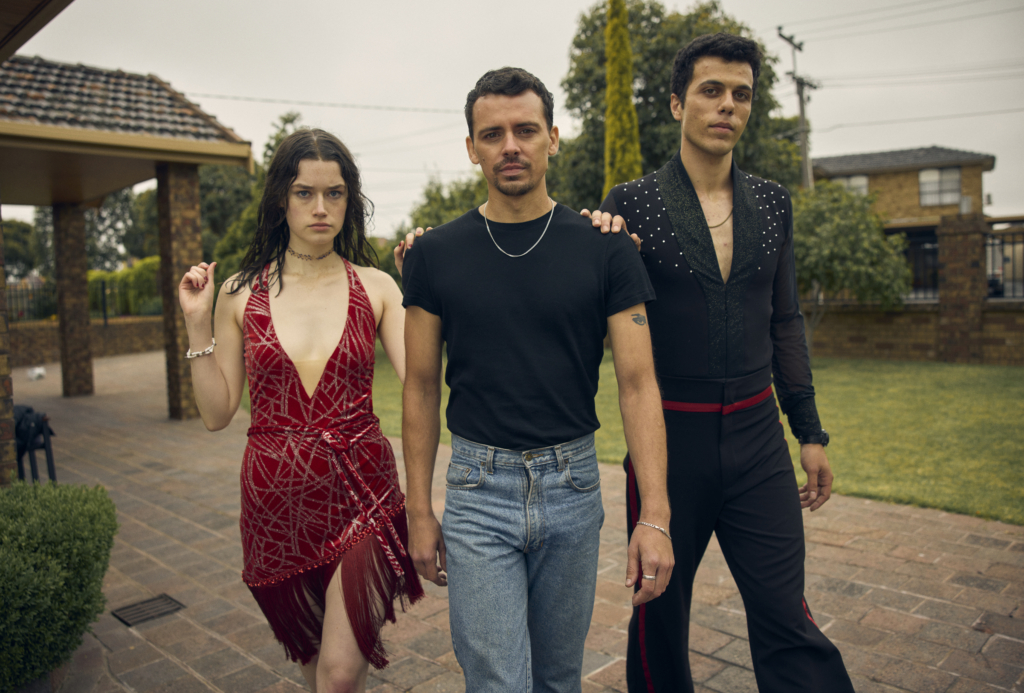
This authenticity goes beyond spectatorial impact, however. As I alluded to in my aforementioned essay, representations of finitude in queer films cut deep because they reflect real-world complications. Queer individuals’ experience of time, Halberstam has found, exists in opposition to ‘the temporal frames of bourgeois reproduction and family, longevity, risk/safety, and inheritance’;[26]Halberstam, op. cit., p. 6. for Schoonover and Galt, in turn, it is one that is less premised on linearity and certainty,[27]Schoonover & Galt, op. cit., pp. 260–1. recalling Ahmed’s assertions about troubled futurity. An offshoot of this is the warping of the conventional coming-of-age pathway: young queers undergo a ‘stretched-out adolescence’ that, for Halberstam, ‘challenges the conventional binary formulation of a life narrative divided by a clear break between youth and adulthood’.[28]Halberstam, op. cit., p. 153. This distinction is made plain in the protagonists’ older forms in the concluding ‘2010’ section. After having lived overseas for some time, Adam and Kol return to Watsonia for Ebony’s wedding; predictably, she is marrying the young man who courted her earlier in the film, her trajectory epitomising the suburban heteronormative ideal. On the surface, Adam has pursued a similar path – he has also gotten married – but reconnecting with Kol stirs some unresolved desolation. Kol fares the worst of the three: while he initially presents in this chapter of the film as a confident, proudly queer person, his carapace crumbles after Adam reveals he is not single. It’s as if we are seeing the same lonely, withdrawn teenager consumed with longing; Kol has emerged not with a full sense of self but with something closer to arrested maturity.
Unlike metronormative coming-of-age and coming-out films that privilege forward motion and ‘freedom’ from the closeted past, Of an Age thrusts Kol and Adam back to the site they sought to escape. For the former, this is a deliberate choice: a decade later, Kol is still (as the press kit puts it) ‘trying to chase [the] feeling’ born of ‘the most intense mind-and-body connection [he] ever [got] to experience’.[29]Focus Features, op. cit., pp. 4, 2. His return to suburbia is, following Padva, nostalgia incarnate – a literalisation of nostos (‘return home’) and algia (‘longing’), a desire ‘for a home that no longer exists or has never existed’.[30]Gilad Padva, Queer Nostalgia in Cinema and Pop Culture, Palgrave Macmillan, New York, 2014, p. 4. In this way, Stolevski’s film not only transgresses subgenre convention but also deftly renders the entwining of queer grief and queer growth: it paints the tensions of yearning for a past that can’t be relived, for belonging where it was never found, for a fire stoked in youth that has been sullied by age and disillusion. In reality, neither coming out nor coming of age is a discrete step; each gradually consolidates with every date, every heartbreak, every affirmation and protestation in the face of family, friends, work and world.[31]For more on this, see Adolfo Aranjuez, ‘Quest and Queerness: Role-playing Identity’, Meanjin, vol. 78, no. 1, 2019, pp. 52–63; and Carolin Emcke, How We Desire, trans. Imogen Taylor, Text Publishing, Melbourne, 2018. When Kol and Adam cuddle on the bed at the film’s end, neither wanting to make love nor wanting the moment to end, they are holding on to that time and place wherein the only home they sought was the universe contained in the other.
Endnotes
| 1 | Michael Sun, ‘Of an Age Review – This Australian Film Is a Modern Queer Classic’, The Guardian, 8 August 2022, <https://www.theguardian.com/film/2022/aug/08/of-an-age-review-this-australian-film-is-a-modern-queer-classic>, accessed 13 October 2022. |
|---|---|
| 2 | Stephen A Russell, ‘Of an Age Is an Instant Australian Classic You Won’t Want to Miss’, Flicks.com.au, 5 August 2022, <https://www.flicks.com.au/reviews/of-an-age-is-an-instant-australian-classic-you-wont-want-to-miss/>, accessed 13 October 2022. |
| 3 | Silvi Vann-Wall, ‘Of an Age Film Is a Tender and Romantic Melburnian Treat’, ScreenHub, 8 August 2022, <https://www.screenhub.com.au/news/reviews/of-an-age-goran-stolevski-miff-2022-film-review-2557560/>, accessed 13 October 2022. |
| 4 | Richard Roxburgh, quoted in Sandy George, ‘Goran Stolevski’s Of an Age Wins Lucrative CinefestOZ Film Prize’, Screen Daily, 30 August 2022, <https://www.screendaily.com/news/goran-stolevskis-of-an-age-wins-lucrative-cinefestoz-film-prize/5173924.article>, accessed 9 October 2022. |
| 5 | See Liam Taft, ‘The Problem with Gay Coming-of-age Movies’, i-D, 7 September 2018, <https://i-d.vice.com/en/article/3ke888/the-problem-with-gay-coming-of-age-movies>, accessed 13 October 2022. |
| 6 | B Ruby Rich, New Queer Cinema: The Director’s Cut, Duke University Press, Durham, NC & London, 2013, p. 132. |
| 7 | Kelly McWilliam, ‘“It Was the Summer When Everything Changed …”: Coming of Age Queer in Australian Cinema’, in Mark David Ryan & Ben Goldsmith (eds), Australian Screen in the 2000s, Palgrave Macmillan, Cham, Switzerland, 2017, p. 193. |
| 8 | ibid. |
| 9 | Michael Bronski, ‘Positive Images & the Coming Out Film: The Art and Politics of Gay and Lesbian Cinema’, Cineaste, vol. 26, no. 1, 2000, pp. 20–1, 23. |
| 10 | Focus Features, Of an Age press kit, 2022, pp. 4, 2. |
| 11 | Gilad Padva, ‘Edge of Seventeen: Melodramatic Coming-out in New Queer Adolescence Films’, Communication and Critical/Cultural Studies, vol. 1, no. 4, 2004, pp. 360–1, 368, emphasis added. |
| 12 | See Bronski, op. cit., p. 23. |
| 13 | Focus Features, op. cit., p. 2. |
| 14 | Goran Stolevski, quoted in Focus Features, ibid., pp. 3, 4. |
| 15 | See Nicholas Manganas, ‘Queering and Querying the Australian Suburbs: Reimagining (Sub)urban Identities’, Coolabah, nos 24 & 25, 2018, pp. 353–5. |
| 16 | See Julie A Podmore & Alison L Bain, ‘Whither Queer Suburbanisms?: Beyond Heterosuburbia and Queer Metronormativities’, Progress in Human Geography, vol. 45, no. 5, 2021, p. 1257. |
| 17 | Eve Kosofsky Sedgwick, cited in Manganas, op. cit., p. 373. |
| 18 | Published under the author’s alternative name, Judith Halberstam. Halberstam, In a Queer Time & Place: Transgender Bodies, Subcultural Lives, New York University Press, New York & London, 2005, pp. 36–7. |
| 19 | Sara Ahmed, ‘Orientations: Toward a Queer Phenomenology’, GLQ: A Journal of Lesbian and Gay Studies, vol. 12, no. 4, 2006, p. 543. |
| 20 | ibid., p. 554. |
| 21 | Stolevski, op. cit., p. 3. |
| 22 | Karl Schoonover & Rosalind Galt, Queer Cinema in the World, Duke University Press, Durham, NC & London, 2016, pp. 211–3. |
| 23 | Adolfo Aranjuez, ‘Love in Time: Confronting Queerness in Call Me by Your Name’, Meanjin, 22 August 2017, <https://meanjin.com.au/blog/love-in-time-confronting-queerness-in-call-me-by-your-name/>, accessed 14 October 2022, emphases in original. |
| 24 | Schoonover & Galt, op. cit., pp. 271–2. |
| 25 | Stolevski, op. cit., p. 11. |
| 26 | Halberstam, op. cit., p. 6. |
| 27 | Schoonover & Galt, op. cit., pp. 260–1. |
| 28 | Halberstam, op. cit., p. 153. |
| 29 | Focus Features, op. cit., pp. 4, 2. |
| 30 | Gilad Padva, Queer Nostalgia in Cinema and Pop Culture, Palgrave Macmillan, New York, 2014, p. 4. |
| 31 | For more on this, see Adolfo Aranjuez, ‘Quest and Queerness: Role-playing Identity’, Meanjin, vol. 78, no. 1, 2019, pp. 52–63; and Carolin Emcke, How We Desire, trans. Imogen Taylor, Text Publishing, Melbourne, 2018. |
